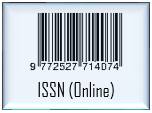COMPARING THE EFFECTIVENESS OF ASSAY FORMULATION FROM VARIOUS TRADITIONAL PLANTS AS PEDICULICIDE AGAINST Pediculus humanus capitis
(1) Pharmacy Programme, Faculty of Medicine, Mataram University, Majapahit Street No. 62, Mataram 83115, Indonesia
(2) Pharmacy Programme, Faculty of Medicine, Mataram University, Majapahit Street No. 62, Mataram 83115, Indonesia
(3) Biology Programme, Faculty of Mathematics and Natural Sciences, Mataram University, Majapahit Street No. 62, Mataram 83115, Indonesia
(*) Corresponding Author
Abstract
Pediculosis capitis is an infection with a fairly high incidence in children. Plants that contain eugenol, as frangipani (Michelia champaca L.), ceylon ironwood (Mesua ferrea L.), cinnamon (Cinnamomum burmannii), and sugar apple (Annona squamosa L.) have potential as an alternative pediculicide. This study aimed to compare the effect of traditional formulation of each plant with in vitro assay. The effectiveness of in vitro pediculicide was assessed from the post- immersion mortality time of the traditional formulation, permethrin 1% as the positive control and coconut oil as the negative control. The mechanism was observed using histopathological observation. The percentage of mortality time of lice was analyzed using One-Way ANOVA of SPSS 16. Histopathological aspects and infestation decrease were presented descriptively. This study took place for about 3 months and was conducted in Mataram University, West Nusa Tenggara. The results showed that frangipani leaves had the optimum pediculicide effect because the highest efficacy demonstrated by frangipani leaves formulation revealed the effect lower than permethrin 1% (LT: 350 minutes). In observation of histopathology, frangipani leaves formulation indicated the presence of anoxia similar to permethrin 1%.
Keywords
Full Text:
PDFReferences
Burgess, I.F., 2009. Current Treatments for Pediculosis Capitis. Curr. Opinin. Infect. Dis., (22)2, 131-136.
Candy, K., Nicolas, P., Andriantsoanirina, V., Izri, A., and Durand, R., 2017. In Vitro Efficacy of Five Essential Oils Against Pediculus humanus capitis. Parasitol. Res., (117)2, 603-609.
Carpinella, M.C., Miranda, M., Almiron, W.R., Ferrayoli, C.G., Almeida, F.L., and Palacios, S.M., 2007. In Vitro Pediculicidal and Ovicidal Activity of An Extract and Oil from Fruits of Melia azedarach L. J. Am. Acad. Dermatol., (56)2, 250-256.
Cestari, I.M., Sarti, S.J., Waib, C.M., and Branco Jr, A.C., 2004. Evaluation of The Potential Insecticide Activity of Tagetes minuta (Asteraceae) Essential Oil Against the Head Lice Pediculus humanus capitis (Phthiraptera: Pediculidae). Neotrop. Entomol., (33)6, 805-807.
Clark, J.M., Yoon, K.S., Lee, S.H., and Pittendrigh, B.R., 2013. Human Lice: Past, Present and Future Control. Pectic. Biochem. Physiol., (106)3, 162-171.
Combescot-Lang, C., Stichele, R.H.V., Toubate, B., Veirron, E., and Mumcuoglu, K.Y., 2015. Ex Vivo Effectiveness of French Over-the- Counter Products Against Head Lice (Pediculus humanus capitis De Geer, 1778). Parasitol. Res., (114)5, 1779-1792.
Dhumal, T.D. and Waghmare, J.S., 2015. A Pediculicidal Activity of Clove Oil. IJPSR., (6)2, 857-865.
Doroodgar, A., Sadr, F., Doroodgar, M., Doroodgar, M., and Sayyah, M., 2014. Examining The Prevalence Rate of Pediculus capitis Infestation According to Sex and Social Factors in Primary School Children. Asian Pac. J. Trop. Dis., (4)1, 25-29.
Feldmeier, H. and Heukelbach, J., 2009. Epidermal Skin Disease: A Neglected Category of Poverty-Associated Plagues. Bull. World Health Organ., (87)2, 152-159.
Heukelbach, J., Canyon, D., and Speare, R., 2007. The Effect of Natural Products on Head Lice: In Vitro Tests and Clinical Evidence. J. Pediat. Inf. Dis., (2)2, 67- 76.
Intaranongpai, J., Chavasiri, W., and Gritsanapan, W., 2006. Anti-Head Lice Effect of Annona squamosa Seeds. Southeast Asian J. Trop. Med. Public Health, (37)3, 532-535.
Kementerian Kesehatan RI, 2010. Profil Kesehatan Indonesia 2009. Kementerian Kesehatan Republik Indonesia, Jakarta.
Mehlhorn, B. and Mehlhorn, H., 2009. Louse Alarm, Düsseldorf University Press.
Mumcuoglu, K.Y., Gilead, L., and Ingber, A., 2009. New Insights in Pediculosis and Scabies. Expert Rev. Dermatol., (4)3, 285-302.
Rassami, W. and Soonwera, M., 2011. Effect of Herbal Shampoo from Long Pepper Fruit Extract to Control Human Head Louse of The Ladkrabang Childrens, Bangkok, Thailand. J. Agri. Tech., (7)2, 331-338.
Rout, P.K., Naik, S.N., and Rao, Y.R., 2011. Composition of The Concrete, Absolute, Headspace and Essential Oil of The Flowers of Michelia champaca Linn. Flavour Fragr. J., (21)6, 906-911.
Shailajan, S., Wadke, P., Joshi, H., and Tiwari. B., 2013. Evaluation of Quality and Efficacy of An Ethnomedicinal Plant Ageratum conyzoides L. in The Management of Pediculosis. J. Young Pharm., (5)4, 139-143.
Soonwera, M., 2014. Efficacy of Herbal Shampoo Base on Native Plant Against Head Lice (Pediculus humanus capitis De Geer, Pediculidae: Phthiraptera) In Vitro and In Vivo in Thailand. Parasitol. Res., (113)9, 3241-3250.
World Health Organization, 2012. Strengthening Civil Registration and Vital Statistics for Births, Deaths and Causes of Death: Resource Kit. World Health Organization, Luxembourg.
Yang, Y.C., Lee, S.H., Lee, W.J., Choi, D.H., and Ahn, Y.J., 2003. Ovicidal and Adulticidal Effects of Eugenia caryophyllata Bud and Leaf Oil Compounds on Pediculus capitis. J. Agric. Food Chem., (51)17, 4884-4888.
Yang, Y.C., Lee, H.S., Clark, J.M., and Ahn, Y.J., 2004. Insecticidal Activity of Plant Essential Oils Against Pediculus humanus capitis (Anoplura: Pediculidae). J. Med. Entomol., (41)4, 699-704.
Yones, D.A., Bakir, H.Y., and Bayoumi, S.A.L., 2016. Chemical Composition and Efficacy of Some Selected Plant Oils Against Pediculus humanus capitis In Vitro. Parasitol. Res., (115)8, 3209-
Yoon, K.S., Previte, D.J., Hodgdon, H.E., Poole, B.C., Kwon, D.H., Abo El-Ghar,G.E., Lee, S.H., and Clark, J.M., 2014. Knockdown Resistance Allele Frequencies in North American Head Louse (Anoplura: Pediculidae) Populations. J. Med. Entomol., (51)2, 450-457.
DOI: https://doi.org/10.24071/jpsc.002088
Refbacks
- There are currently no refbacks.
Copyright (c) 2021 Jurnal Farmasi Sains dan Komunitas (Journal of Pharmaceutical Sciences and Community)
Jurnal Farmasi Sains dan Komunitas (Journal of Pharmaceutical Sciences and Community)
Published by Faculty of Pharmacy, Universitas Sanata Dharma Yogyakarta

This work is licensed under a Creative Commons Attribution 4.0 International License.













.png)













